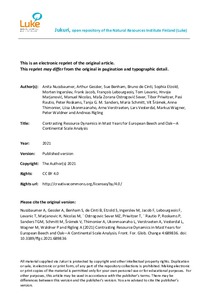Contrasting Resource Dynamics in Mast Years for European Beech and Oak—A Continental Scale Analysis
Nussbaumer, Anita; Gessler, Arthur; Benham, Sue; de Cinti, Bruno; Etzold, Sophia; Ingerslev, Morten; Jacob, Frank; Lebourgeois, François; Levanic, Tom; Marjanović, Hrvoje; Nicolas, Manuel; Ostrogović Sever, Maša Zorana; Priwitzer, Tibor; Rautio, Pasi; Roskams, Peter; Sanders, Tanja G. M.; Schmitt, Maria; Šrámek, Vít; Thimonier, Anne; Ukonmaanaho, Liisa; Verstraeten, Arne; Vesterdal, Lars; Wagner, Markus; Waldner, Peter; Rigling, Andreas (2021)
Nussbaumer, Anita
Gessler, Arthur
Benham, Sue
de Cinti, Bruno
Etzold, Sophia
Ingerslev, Morten
Jacob, Frank
Lebourgeois, François
Levanic, Tom
Marjanović, Hrvoje
Nicolas, Manuel
Ostrogović Sever, Maša Zorana
Priwitzer, Tibor
Rautio, Pasi
Roskams, Peter
Sanders, Tanja G. M.
Schmitt, Maria
Šrámek, Vít
Thimonier, Anne
Ukonmaanaho, Liisa
Verstraeten, Arne
Vesterdal, Lars
Wagner, Markus
Waldner, Peter
Rigling, Andreas
Julkaisusarja
Frontiers in forests and global change
Volyymi
4
Sivut
17 p.
Frontiers
2021
Julkaisun pysyvä osoite on
http://urn.fi/URN:NBN:fi-fe2021100850416
http://urn.fi/URN:NBN:fi-fe2021100850416
Tiivistelmä
Resource allocation to different plant tissues is likely to be affected by high investment into fruit production during mast years. However, there is a large knowledge gap concerning species-specific differences in resource dynamics. We investigated the influence of mast years on stem growth, leaf production, and leaf carbon (C), nitrogen (N), and phosphorus (P) concentrations and contents in Fagus sylvatica, Quercus petraea, and Q. robur at continental and climate region scales using long-term data from the International Co-operative Programme on Assessment and Monitoring of Air Pollution Effects on Forests (ICP Forests) and similar datasets. We discussed the results in the light of opposing resource dynamics hypotheses: (i) resource accumulation before mast years and exhaustion after mast years (resource storage hypothesis), (ii) shifting resources from vegetative to generative compartments (resource switching hypothesis), and (iii) investing resources concurrently in both vegetative and generative compartments (resource matching hypothesis). Linear mixed-effects modelling (LMM) showed that both stem growth and leaf production were negatively influenced by weather conditions which simultaneously lead to high fruit production. Thus, the impact of generative on vegetative growth is intermixed with effects of environmental factors. Superposed epoch analyses and LMM showed that for mast behaviour in F. sylvatica, there are indicators supporting the resource storage and the resource switching hypotheses. Before mast years, resources were accumulated, while during mast years resources switched from vegetative to generative tissues with reduced stem and leaf growth. For the Quercus species, stem growth was reduced after mast years, which supports the resource storage hypothesis. LMM showed that leaf C concentrations did not change with increasing fruit production in neither species. Leaf N and P concentrations increased in F. sylvatica, but not in Quercus species. Leaf N and P contents decreased with increasing fruit production in all species, as did leaf C content in F. sylvatica. Overall, our findings suggest different resource dynamics strategies in F. sylvatica and Quercus species, which might lead to differences in their adaptive capacity to a changing climate.
Collections
- Julkaisut [87086]
